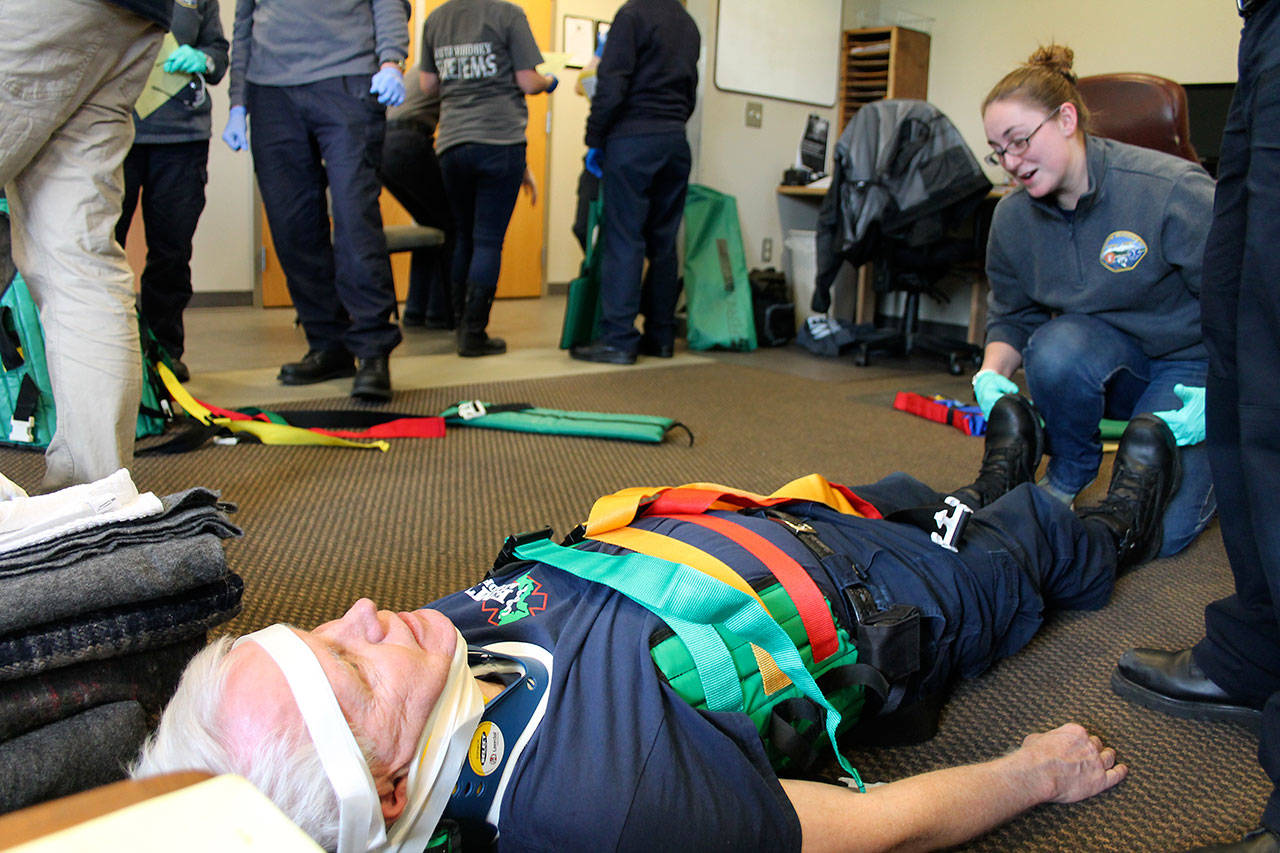Not all classrooms are set in school buildings and lecture halls.
In the common area of South Whidbey Fire/EMS Station 31 in Freeland, an eclectic group of students surround a patient sitting upright. A retired physician, an aspiring armed serviceman in his 20s and an active medical researcher work together to apply a neckbrace and Kendrick Extrication Device — basically a back brace — before lifting the patient and laying him on the ground. But rather than proceeding to provide medical treatment, an instructor scans through a checklist, critiques their performance and gives them pointers.
This is Whidbey Island EMT Academy, where long hours are dedicated to training the island’s next crop of lifesavers.
“When I went through the class in 2004, I found it pretty overwhelming,” 17-year district veteran volunteer and instructor Ken Starkweather said. “These days, I’ve been helping with EMT Academy just to freshen up my memory.”
Volunteers from fire departments across Whidbey annually convene on the South End every Saturday for 20 weeks to go through the course. The volunteers, who are a hodgepodge of people from various professions, ages and walks of life, spend a total of 181 hours together to complete the course and attain their EMT certification. There are 18 new EMT trainees this year, nine of whom are from South Whidbey Fire/EMS. Every minute aspect of emergency response training is covered in EMT Academy, from trauma patient assessment to the administration of CPR.
On Saturday, trainees were practicing non-urgent patient extrication, a scenario where an injured patient sitting upright in a vehicle would need to be safely removed. Trainees could also be found handling a needle and vile of epinephrine to practice treating a patient with an allergic reaction. It was all new material for the trainees, even for those who are retired medical professionals such as new South Whidbey Fire/EMS volunteer Mark Jabbusch.
“It’s like going back to college for a full course,” Jabbusch, a retired physician, said. “There are ride-alongs, class time, hands-on learning; we basically cover everything under the sun. Emergency medicine is totally different from clinical medicine, so I’m as new to this as anyone else.”
EMT training wasn’t always this demanding. The amount of hours required to cover the course materials has risen considerably in the past few decades, as emergency medicine grows more technical and advanced. When Starkweather was taking the course in 2004, EMT Academy was 150 hours in total. Deputy Chiefs Mike Cotton and Wendy Moffatt say their training in the ’80s and ’90s respectively took about 80 hours, less than half of what’s required today.
That’s because fire departments are expected to handle emergency situations of all kinds, even departments like South Whidbey Fire/EMS that are primarily made up of volunteers. When a tree falls and blocks the road, the fire department is called. When a girl is stuck 80 feet up in a tree, the fire department is called. Volunteer forces are expected to be familiar with medications and how to administer them, and also have to be prepared to handle hazardous materials. How to treat overdoses and handle mental health concerns are new additions that weren’t extensively covered in the past.
“Training and expectations have changed over the years from when I started,” Moffatt said. “Volunteer EMTs have to know medications patients may need and adverse side effects. Even if you had a career in clinical medicine, you have to start back at square one since emergency medicine follows different rules.”
The increased amount of knowledge expected of volunteers and time demands required for the job comes in the face of a rising number of emergency calls. South Whidbey Fire/EMS responded to 2,600 calls in 2016, a significant increase from the 1,867 calls recorded in 2012. Chief Rusty Palmer said 78 percent of those were medical calls, a percentage which will likely increase as Whidbey’s population continues to age.
That will happen at a time when volunteer levels are on the decline. Cotton estimates South Whidbey Fire/EMS had a team of about 100 volunteers 15 years ago, but the district currently has 43 volunteers on its roster today. Since then, the district has set aside funds to pay part-time firefighters to fill the void, a trend Palmer says is nationwide. It’s also increasingly difficult to have a high volunteer turnout for calls during the week, as Palmer says it’s not as easy to leave work as it once was.
“The time demands are growing, and that’s probably the primary reason for the lower amount of volunteers nationwide,” Palmer said. “The amount of knowledge required to do the job has greatly increased, and that’s partly because of new hazards, technology and the amount of regulations that guide what we do.”
Whidbey Island EMT Academy is, in many ways, training South Whidbey’s unsung heroes. While firefighters regularly receive press coverage for their actions, EMTs often aren’t publicly recognized due to the privacy of personal health information ensured by the Health Insurance Portability and Accountability Act (HIPAA). As a result, newspapers rarely write about emergency medical calls, unlike public events such as fires and car accidents. Yet, EMS is the bulk of South Whidbey Fire/EMS’s work.
For Palmer, the EMTs don’t get the credit they deserve. But he was also clear the district could use more of them.
“Considering all the bad things that can happen to a person, you want people to come to your side that are skilled, trained, compassionate and really know how to do their job,” Palmer said. “The EMTs can have an impact in the most positive way, or they may have an impact in the last moments of a person’s life, and we strive to make that moment positive. We just need more people to make that positive impact.”



